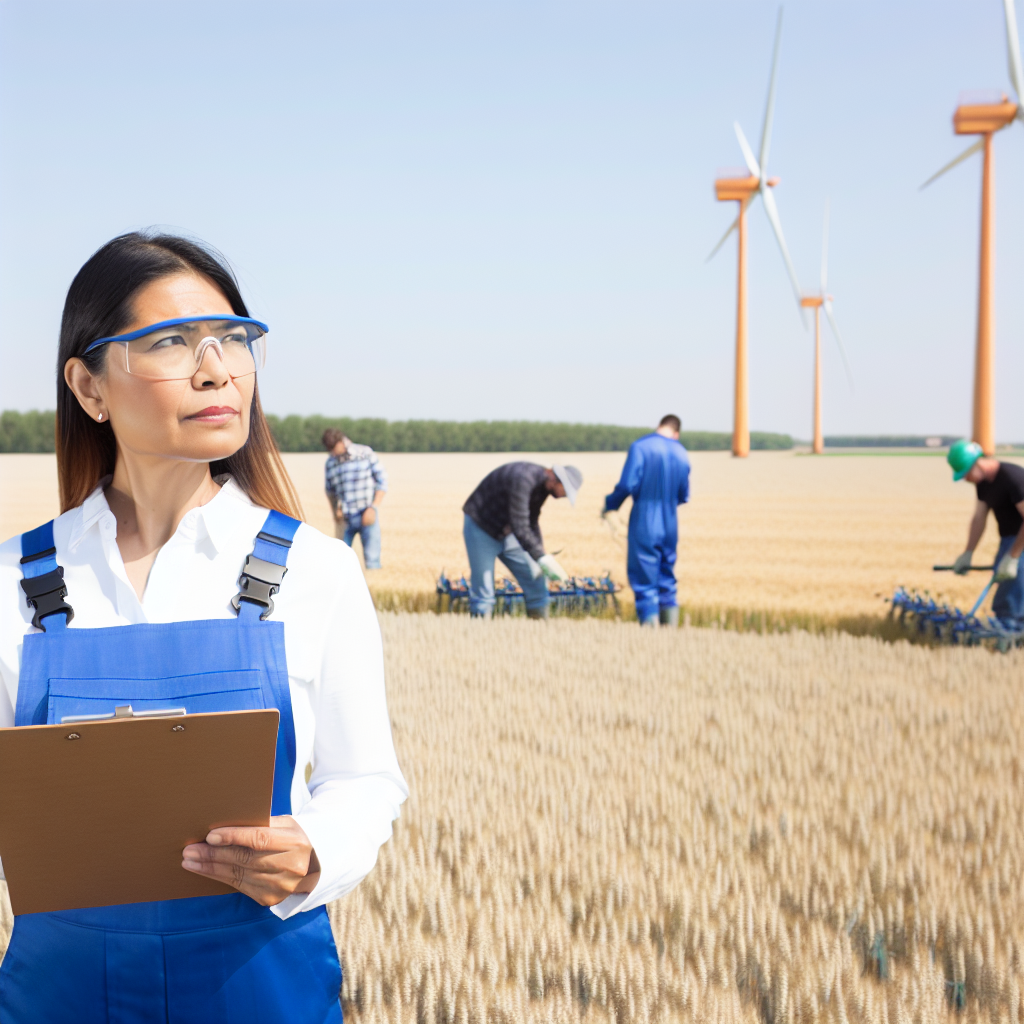Introduction to Environmental Impact Assessments in Agriculture
Environmental impact assessments, or EIAs, play a crucial role in agriculture.
They evaluate the potential environmental effects of farming practices.
Thus, farmers, policymakers, and stakeholders can make informed decisions.
Purpose of Environmental Impact Assessments
EIAs aim to identify significant environmental impacts before project initiation.
They promote sustainability and resource conservation in agricultural practices.
Additionally, they help mitigate negative effects on ecosystems.
Steps Involved in Conducting an EIA
First, practitioners must screen projects to determine if an EIA is needed.
Next, they conduct a scoping process to identify key issues and impacts.
Following that, data collection and analysis occur to assess potential effects.
Then, stakeholders review the findings and provide input.
Finally, the EIA report is prepared and submitted for decision-making.
Benefits of Environmental Impact Assessments
One significant benefit is enhanced decision-making, promoting better project outcomes.
Moreover, EIAs contribute to environmental protection and sustainable development.
They also foster community engagement by involving local populations.
Ultimately, EIAs can lead to more resilient agricultural systems.
Transform Your Agribusiness
Unlock your farm's potential with expert advice tailored to your needs. Get actionable steps that drive real results.
Get StartedChallenges in Implementing EIAs
Despite their benefits, implementing EIAs can be challenging.
Limited resources often hinder thorough assessments.
Additionally, varying regulations across regions complicate standardization.
Furthermore, agricultural practices constantly evolve, requiring regular updates to assessments.
Lastly, public perception and awareness can impact EIA effectiveness.
Importance of Assessing Environmental Impacts in Agricultural Practices
Understanding Environmental Impact Assessments
Environmental impact assessments, or EIAs, are crucial in agriculture.
They evaluate the potential environmental effects of proposed agricultural practices.
Through these assessments, we gain valuable insights into ecological risks.
Moreover, EIAs help in identifying ways to mitigate negative impacts.
Promoting Sustainable Practices
Assessments promote sustainable agricultural practices among farmers.
They encourage the adoption of techniques that minimize environmental harm.
Farmers can reduce soil erosion, water use, and pesticide dependency.
Consequently, sustainable practices lead to healthier ecosystems.
Protecting Biodiversity
Biodiversity is essential for resilient agricultural systems.
Environmental assessments help protect various species in farming areas.
They identify habitats that require protection during agricultural expansion.
By focusing on biodiversity, agriculture can sustain vital ecological processes.
Regulatory Compliance and Funding Opportunities
EIAs ensure that agricultural projects comply with environmental regulations.
Compliance is necessary for securing government funding and support.
Farmers can access grants and incentives for environmentally-friendly practices.
Hence, EIAs play a role in financing sustainable agriculture initiatives.
Error Reduction and Risk Management
Through EIAs, farmers can identify and reduce potential risks.
They help anticipate issues related to soil quality, water availability, and pollution.
This proactive approach minimizes costly mistakes in agricultural production.
Showcase Your Farming Business
Publish your professional farming services profile on our blog for a one-time fee of $200 and reach a dedicated audience of farmers and agribusiness owners.
Publish Your ProfileUltimately, effective risk management enhances farm profitability.
Key Components of Environmental Impact Assessments in Farming
Definition and Purpose
Environmental Impact Assessments (EIAs) evaluate potential environmental effects of agricultural projects.
These assessments inform decision-makers about ecological impacts.
Ultimately, they aim to mitigate negative outcomes through careful planning.
Stakeholder Involvement
Engaging stakeholders is vital for effective EIAs in agriculture.
Farmers, local communities, and environmental groups share valuable insights.
Moreover, collaboration enhances transparency and trust among all parties.
Baseline Environmental Conditions
Understanding existing environmental conditions is essential.
Baseline data provides a reference point for measuring impacts.
Common elements include water quality, soil health, and biodiversity levels.
Assessment of Potential Impacts
Evaluating the potential impacts of agricultural practices follows baseline analysis.
Impacts can be direct, indirect, cumulative, or residual.
For instance, pesticide application may lead to waterway contamination.
Risk Analysis and Management
Risk analysis examines the likelihood of adverse effects occurring.
This process helps prioritize which impacts require management strategies.
Furthermore, adaptive management allows for adjustments based on ongoing monitoring.
Mitigation Strategies
Developing mitigation strategies is a crucial component of EIAs.
Effective strategies minimize adverse impacts on the environment.
Examples include implementing crop rotation and buffer strips along waterways.
Monitoring and Evaluation
Ongoing monitoring assesses the effectiveness of implemented strategies.
This evaluation ensures compliance with environmental standards and regulations.
As a result, farmers can adapt practices based on monitoring findings.
Reporting and Communication
Clear reporting is essential to communicate findings and recommendations.
Transparent communication fosters understanding among stakeholders.
Consequently, it aids in building a culture of environmental responsibility in agriculture.
Gain More Insights: Overview Of Organic Farming Regulations
Challenges and Limitations of Conducting EIAs in Agriculture
Complexity of Agricultural Systems
Agricultural systems are complex and dynamic.
They involve various interrelated factors like soil, water, and climate.
This complexity poses challenges for accurate assessments.
Furthermore, changes in one component can affect others significantly.
Thus, predicting environmental impacts becomes more difficult.
Lack of Standardization
Countries often lack standardized EIA procedures for agriculture.
This inconsistency leads to varied results across regions.
As a result, stakeholders may find it hard to compare EIAs.
Moreover, the variation can create confusion among farmers and regulators.
Data Availability and Quality
Access to reliable data remains a major obstacle.
In many areas, data on local ecosystems is scarce.
Without quality data, EIAs cannot accurately predict impacts.
Furthermore, outdated information can lead to poor decision-making.
Stakeholder Engagement
Effective stakeholder engagement is often insufficient.
Showcase Your Farming Business
Publish your professional farming services profile on our blog for a one-time fee of $200 and reach a dedicated audience of farmers and agribusiness owners.
Publish Your ProfileFarmers may feel excluded from the EIA process.
Additionally, their knowledge and concerns may be overlooked.
This disengagement can negatively impact the validity of EIAs.
Time and Resource Constraints
Conducting thorough EIAs requires considerable time and resources.
Many agricultural projects face tight deadlines.
This urgency often compromises the depth of assessments.
Consequently, crucial environmental factors might be ignored.
Economic Pressures
Economic considerations heavily influence agricultural practices.
Producers often prioritize short-term gains over long-term sustainability.
This focus can lead to decisions that harm the environment.
Moreover, financial constraints may limit EIA funding and support.
Learn More: Essential Steps for Farmers to Apply for Research and Development Grants
Case Studies of Successful EIAs Leading to Sustainable Agricultural Practices
Organic Farming Initiatives in California
California has implemented various organic farming initiatives effectively.
One significant case involved the Hudson Family Farm.
They conducted an Environmental Impact Assessment before expanding their operations.
As a result, they adopted eco-friendly practices that reduced pesticide use.
This action enhanced local biodiversity significantly.
Consequently, the farm improved its soil health and crop yield.
Moreover, surrounding communities benefitted from reduced chemical runoff.
In essence, the EIA empowered Hudson Family Farm to thrive sustainably.
Agroforestry Implementation in Brazil
Brazil presents a remarkable example of agroforestry initiatives.
The Silva Agroforestry Project utilized EIAs to evaluate land use changes.
This project integrated trees with crops and livestock effectively.
Initially, the EIA revealed potential adverse effects of monoculture farming.
As a result, stakeholders embraced more diverse farming methods.
This led to improved soil fertility and water retention rates.
Additionally, it helped mitigate deforestation pressures in the Amazon.
Such collaborative approaches demonstrate EIA’s role in sustainable agriculture.
Wetland Restoration in Louisiana
The state of Louisiana has embarked on notable wetland restoration efforts.
The Coastal Wetlands Planning, Protection, and Restoration Act initiated comprehensive EIAs.
This act addresses the impacts of agriculture on critical wetland ecosystems.
Under this initiative, many farmers have adopted sustainable practices.
They practice crop rotation and reduced tillage to improve soil health.
Moreover, these measures contribute to enhanced water quality and habitats.
The success stories highlight the practical value of EIAs in agriculture.
Ultimately, these practices lead to more resilient agricultural systems.
You Might Also Like: Understanding Farm-To-Table Legislation: A Comprehensive Guide for Farmers
Regulatory Framework Governing EIAs in Agricultural Sectors
Introduction to Environmental Impact Assessments
Environmental Impact Assessments (EIAs) evaluate potential environmental effects of agricultural practices.
They play a crucial role in sustainable agriculture development.
Governments and organizations enforce these assessments to mitigate adverse impacts.
Showcase Your Farming Business
Publish your professional farming services profile on our blog for a one-time fee of $200 and reach a dedicated audience of farmers and agribusiness owners.
Publish Your ProfileLegislative Background
Various laws govern the implementation of EIAs in agriculture.
National Environmental Policy Act (NEPA) in the United States mandates EIAs for federal projects.
In Europe, the EU Directive on Environmental Impact Assessment sets the groundwork.
These regulations promote informed decision-making processes.
Institutional Framework
Multiple institutions oversee the implementation of EIAs in agriculture.
Government agencies like the Environmental Protection Agency (EPA) in the U.S. ensure compliance.
State and local agencies adapt regulations to meet regional needs.
International organizations, such as the Food and Agriculture Organization (FAO), provide guidelines.
Key Components of EIAs
EIAs generally include several critical components.
- Identification of potential environmental impacts
- Assessment of baseline environmental conditions
- Development of mitigation measures
- Stakeholder engagement and public consultation
Each component is essential for thorough environmental evaluations.
Challenges in EIA Implementation
Implementing effective EIAs in agriculture faces numerous challenges.
Resource constraints limit many agencies’ capabilities.
Furthermore, the lack of standardized procedures can lead to inconsistencies.
Additionally, some stakeholders may resist compliance due to cost concerns.
Future Directions for EIAs
Improving the regulatory framework for EIAs in agriculture is essential.
Integrating advanced technologies, such as remote sensing, can enhance assessments.
Moreover, fostering collaborative approaches among stakeholders can yield better outcomes.
Ultimately, adapting regulations to emerging environmental challenges will be vital.
Uncover the Details: Key Sources of Research and Development Funding for Agricultural Businesses

Future Trends in Environmental Impact Assessments for Sustainable Development in Agriculture
Integrating New Technologies
Advancements in technology are transforming environmental impact assessments in agriculture.
Farmers increasingly use drones to monitor crop health and soil conditions.
This technology enhances data collection efficiency and accuracy.
Moreover, machine learning algorithms help analyze environmental data more effectively.
As a result, farmers can make informed decisions for sustainable practices.
Emphasizing Stakeholder Involvement
Collaboration among stakeholders is critical for successful assessments.
Public engagement fosters transparency and trust within communities.
Farmers, local residents, and environmental groups must collaborate closely.
This involvement ensures that diverse perspectives influence decision-making.
Ultimately, it leads to more effective and widely accepted policies.
Adopting Comprehensive Assessment Methods
The trend towards holistic assessments is gaining momentum in the industry.
These methods evaluate not only environmental factors but also social impacts.
For instance, assessing community health and economic viability is crucial.
Such comprehensive evaluations promote balanced agricultural practices.
They help minimize adverse effects while maximizing benefits to local communities.
Utilizing Data-Driven Techniques
Data analytics is reshaping the way environmental impacts are assessed.
Farmers can harness big data to identify trends and predict outcomes.
This approach empowers them to adapt practices proactively.
Consequently, the agricultural sector can improve resilience against climate change.
Data-driven techniques facilitate continuous improvement in farming practices.
Strengthening Regulatory Frameworks
Regulatory bodies are increasingly recognizing the importance of environmental assessments.
Showcase Your Farming Business
Publish your professional farming services profile on our blog for a one-time fee of $200 and reach a dedicated audience of farmers and agribusiness owners.
Publish Your ProfileStronger regulations ensure that sustainable practices are implemented effectively.
For example, policies may require detailed assessments before project approvals.
This focus reinforces accountability among agricultural enterprises.
Clear guidelines will also aid farmers in meeting environmental compliance standards.
Promoting Circular Economy Practices
The concept of a circular economy is becoming integral to agriculture.
This approach emphasizes resource reuse and waste reduction.
Farmers can integrate organic waste into their production systems.
Additionally, innovative techniques promote soil rejuvenation and biodiversity.
Such practices help sustain the environment while boosting productivity.
Role of Technology and Innovation in Enhancing EIAs in Agriculture
Introduction to Environmental Impact Assessments
Environmental Impact Assessments (EIAs) play a crucial role in agriculture.
They ensure agricultural practices maintain environmental integrity.
Technology and innovation significantly enhance these assessments.
Advanced Data Collection Methods
Modern technology facilitates advanced data collection.
Remote sensing allows for real-time monitoring of agricultural land.
This technology provides critical information on crop health.
Moreover, drones capture detailed images of field conditions.
Data Analysis and Modeling
Advanced analytics and modeling techniques improve EIA outcomes.
Machine learning algorithms can identify patterns in environmental data.
These insights enable better decision-making for land use.
Additionally, predictive models help foresee environmental impacts.
Stakeholder Engagement Through Digital Platforms
Innovative digital platforms enhance stakeholder engagement.
Web-based tools allow farmers, scientists, and policymakers to collaborate.
Online forums and workshops promote knowledge sharing.
This collaborative approach fosters more informed EIA processes.
Integration of Sustainable Practices
Technological advancements encourage sustainable agricultural practices.
Precision agriculture minimizes resource wastage and limits environmental harm.
Furthermore, innovations in biodegradable materials reduce pollution.
These practices align agricultural methods with environmental conservation efforts.
The Future of EIAs in Agriculture
AI and machine learning will revolutionize future EIAs in agriculture.
They will facilitate quicker assessments and more accurate predictions.
Furthermore, real-time data integration will streamline the EIA process.
The future promises a more efficient framework for sustainable agriculture.
Stakeholder Engagement in the EIA Process for Agricultural Projects
The Importance of Stakeholder Engagement
Engaging stakeholders enhances the Environmental Impact Assessment (EIA) process.
It ensures diverse perspectives are considered during project planning.
Moreover, involving stakeholders can increase transparency and trust.
Identifying Relevant Stakeholders
Effective engagement starts with identifying relevant stakeholders.
Farmers, local residents, and community organizations are key participants.
Additionally, regulatory bodies and environmental groups should be included.
Understanding their interests helps shape the EIA process effectively.
Methods of Engagement
Utilizing various methods helps gather stakeholder input efficiently.
Showcase Your Farming Business
Publish your professional farming services profile on our blog for a one-time fee of $200 and reach a dedicated audience of farmers and agribusiness owners.
Publish Your ProfilePublic meetings foster open discussions about project impacts.
Surveys enable stakeholders to provide feedback anonymously.
Workshops allow for collaborative problem-solving and idea sharing.
Building Relationships
Building positive relationships with stakeholders is crucial.
Consistent communication demonstrates commitment to their concerns.
Furthermore, addressing issues promptly can strengthen trust.
Engaged stakeholders are more likely to support sustainable practices.
Feedback Mechanisms
Implementing feedback mechanisms is vital for continuous improvement.
Stakeholders should have opportunities to voice concerns throughout the EIA process.
Additionally, regular updates on project developments are essential.
This transparency cultivates a cooperative atmosphere among all parties.
Evaluating Engagement Effectiveness
Evaluating the effectiveness of stakeholder engagement is necessary.
Collecting feedback on the engagement process can highlight areas for improvement.
Subsequently, adapting strategies based on insights can lead to better outcomes.
Ultimately, effective engagement contributes to more informed decision-making.
Additional Resources
U.S. Department of Agriculture Releases Final Environmental Impact …




